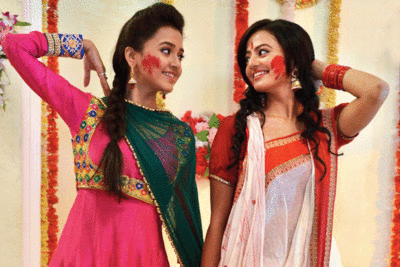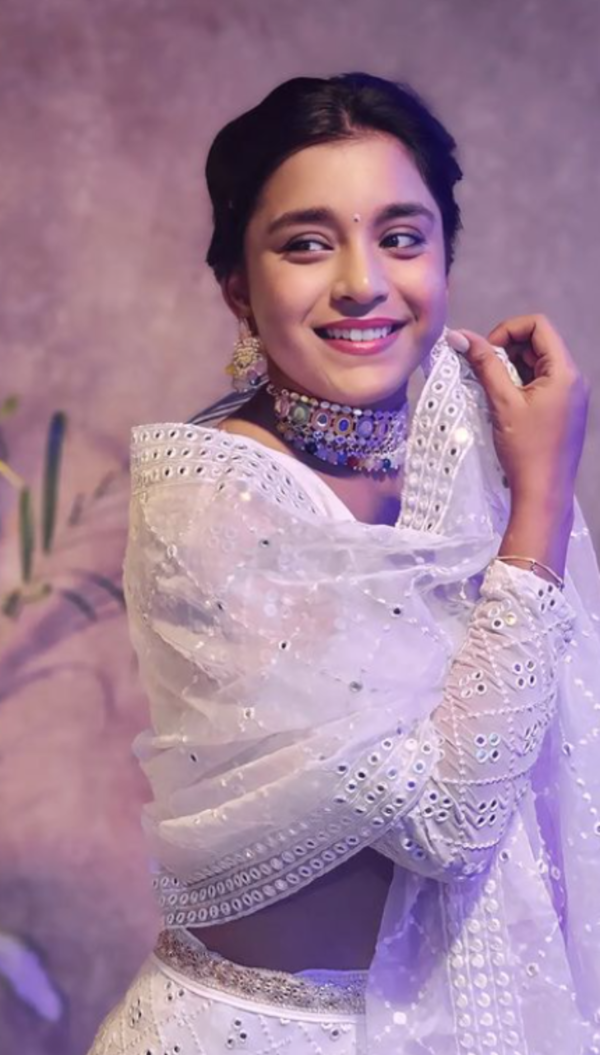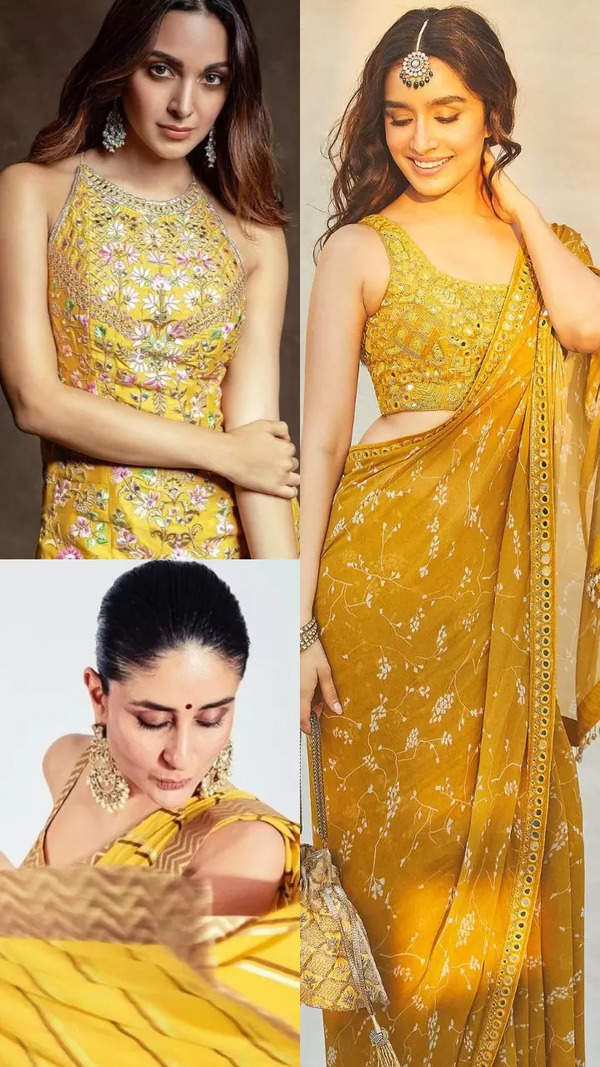Trending
This story is from March 8, 2016
Weepy, oppressed women on screen, paid more than men off it
The TV industry may be slammed for regressive portrayals of women – but the women who portray these roles dominate screen space and are paid more than the men

The TV industry may be slammed for regressive portrayals of women – but the women who portray these roles dominate screen space and are paid more than the men. Paradoxical women’s empowerment, anyone?
READ ALSO:
Rashmi Desai: TV is for masses, has more reach than films
The gender pay gap is an oft-visited topic when debating sexism in Hollywood and Bollywood. Every few days, we have someone from the industry addressing the issue and talking about how actresses get paid less as compared to their male counterparts.But on this International Women’s Day, we bring you a silver lining – on the Indian small screen, the situation is the reverse. Here, it is the women who play the lead and the superhero and fight the villains – also played by women– and get paid more for it.
READ ALSO:
Meri Awaaz Hi Pehchaan Hai: Know all about the show
WOMEN RAKE IN THE MOOLAH
Not only do the female leads get more screen space than the men, they also get paid more. While the wages are decided basis an actor’s popularity, the female leads can call the shots if their show gets high ratings. An industry insider says, “In 'Uttaran', Tina Datta was paid close to `70,000 per day, while her co-star Mrunal Jain was paid around `30,000. When 'Madhubala-Ek Ishq Ek Junoon' went on air, Drashti Dhami was paid more than double of what Vivian Dsena was paid. But after Vivian’s character became popular, he was paid the same as Drashti. When Pavitra Rishta was on air, Ankita Lokhande was always given a hike and more screen space whenever she considered quitting the show, which was several times. Women end up earning more because they shoot for more days than the male actors. Whenever the channel wants to take their actors for promotional trips, they want the female lead to travel, while the male lead’s presence is optional. Even for appearances at events and weddings, it’s the female lead who is required to travel more. So, they end up making more money.”
A producer, without wishing to be named, says, “An actress knows how to use the fact that she is an indispensable part of a show. Agar show ko saat saal ho gaye hain, toh channel bhi nahi chahta ki heroine show chhod ke jaaye. Woh jitne paise maangti hain, humein dena padta hai. (The channels don't wish for the heroine to leave their show once it completes a certain number of years. They get paid according to their demands then.) Once, the female lead refused to come for shoots and didn’t even take our calls because she wanted a hike. We had to contact her mother and request her to come back. Har subah hum uththe hain darte huye ki kis actress ne dhamki di hai show chhodne ki (We're really scared of actresses leaving shows mid-way) .”
READ ALSO:
Ssharad Malhotra's new show depicts the magic of love
WHILE WOMEN RULE THE ROOST, MEN ARE THE EYE CANDY
On TV, the female protagonists are rarely seen ditching their saris and anarkalis for more revealing outfits, while it’s quite common for the men to show off their muscles. Producer and director Ravindra Gautam has an interesting observation. He says, “On TV, men have to be the eye candy, while the women have to be good actors. Since the audience is mostly female, we have to make sure that the male actors are good-looking. Somewhere, there’s that aspiration among women that, ‘My husband should also be like this hero’.”
Shows like 'Naagin', 'Ishq Ka Rang Safed', 'Kumkum Bhagya' have all shown their male leads shirtless or wearing just a ganjee. Shows that have featured Gautam Rode, Karan Singh Grover and Gurmeet Choudhary always have shirtless scenes with them.Narratives and tracks are written for women.
READ ALSO:Ekta Kapoor: TV shows are diluted to not hurt sensibilities
Industry insiders say that when it comes to tracks and storylines, it’s been observed that if the track revolves only around men, the ratings witness a fall. For instance, in 'Diya Aur Baati Hum', the makers experimented with a Kabaddi track where the male protagonist was in focus, but that didn’t get ratings and the makers had to introduce the track where the woman protagonist was shown fighting terrorists and saving the country from the threat of a nuclear attack. Even in other shows, the tracks are written ensuring that women stay in the driver’s seat.
Nivedita Basu, producer of 'Meri Awaaz Hi Pehchaan Hai', says, “I have been working with Ekta (Kapoor) since 2000 from the time of 'Kyunki Saas Bhi Kabhi Bahu Thi' and we have seen that the issues onscreen always need to have a female viewpoint. In 'Itna Karo Na Mujhe Pyaar', the poster of the show had Ronit Roy and Pallavi Kulkarni, but the narrative was such that women would empathise with the protagonist. If a woman leaves a man, people think he will find solace in his friends’ company, go out, but if a woman is deserted by a man, women empathise with her struggles and her pain. We have made love stories like 'Kahiin Toh Hoga' and while the poster of the show might have had both the female and the male leads, the narrative was always from a woman’s perspective. In 'Kyunki...', when there was a situation where two sons of the family were against each other, we showed Tulsi’s dilemma and how she made her choices. The attention span of the viewers is very small and if they lose interest in your show, they will never come back. I think a show about the rivalry of two men over a piece of land won’t work, but if the rivalry is over a girl, women will connect with the show.”
READ ALSO:
TV Celebs flaunt grey shades
MAJOR TV-WATCHING AUDIENCE IS WOMEN
Most of the writers and makers confess that TV is considered a medium that is only watched by women, and while men watch news and sports, it’s the women who watch these tear-jerkers. Nivedita says, “TV in India has always been about what women watch. Before reality TV came in, men used to watch sports and news channels and later, they were the ones who would watch 'Comedy Nights With Kapil', 'Bigg Boss', while the main content, that is the daily soaps, are all targeted at women.”
Pawan Kumar, director of shows like 'Swaragini' and 'Sasural Simar Ka', says, “TV dekhne waali audience auratein hoti hain (Women make up majority of TV watching audience). Men don’t watch TV and the Indian woman means the homemaker – they comprise 60% of our population. When men leave for work and children leave for school, women spend their time watching TV. The small screen is a playground where women play with the other women. Agar aurat positive role karti hai toh negative role bhi aurat hi karti hai because it’s targeted completely on women (positive as well as negative roles are played by women).”
READ ALSO:TV Celebs upset about not being paid
THE WOMEN CHARACTERS CAN NEVER LEAVE THEIR HUSBANDS
Often, the female leads are projected as ‘sati-savitri’, ‘tyaag ki murti’ and writers confess that these are the unwritten rules when it comes to female characters. Gautam says, “Just like there’s a rule that the husband and wife will not consummate immediately after their marriage, there’s a thumb rule that the woman will never leave her husband. Pati kuch bhi kar le but woh usey nahi chhodegi (The woman never leaves her husband) . Even if he’s cheating on her or treating her badly, she will change him but not leave him. They are aspirational characters because women compare themselves to these ladies and the pain they go through on screen.”
Gajra Kottary, writer of 'Balika Vadhu', says, “Our characters have to be relatable and aspirational. They have to be relatable but not realistic. There has to be an instant connect with them. There cannot be many layers to their personality and they cannot have grey shades. To achieve realism, you have to have grey shades in your characters but that is not possible on TV. The characters are uni-dimensional in the way they behave.”
READ ALSO:
Telly Hotties get more screen time
IRONIC THAT TV IS RE-INFORCING STEREOTYPES
Kottary adds, “Women, traditionally and classically, have considered to be TV viewers. The content is made to please them and they are the drivers of the small screen. Even when it comes to running the TV industry, there are more women than men who are doing so. However, these same women, as a class and gender, are re-inforcing stereotypes, and unfortunately, have their heart in the wrong place. While women might be getting more screen-space and good money, it ultimately is lip-service. Here’s this woman who’s quite liberated, dresses up the way she wants to, but she’s propagating the message of ‘maang bharo sajna’ through her shows. That’s what is upsetting. The imagery is so ironic.”
However, Nivedita begs to differ with Kottary and says, “We’ve had very independent women characters. There was a time when we showed Mihir Virani sitting at home while Tulsi Virani called the shots at work. In 'Kasauti Zindagi Kay', we had Prerna Bajaj pipping Cezanne’s character in business and even in 'Kkusum', the female lead was seen taking the charge. Of course, the saas-bahu war is there where the saas thinks that my son is my property. There is some regressive content, but you also have 'Ye Hai Mohabbatein' where Ishita, who is educated and a dentist by profession, marrying for the love of a child. The concept differs from show to show.”
READ ALSO:
Vivian Dsena back with a fiction show?
TV IS A LEVEL PLAYING FIELD
Producer Vikas Gupta opines, “There is no concept of heroes and heroines on television. On television, an actress playing the mother-in-law could be paid double than the male lead of the show. Television as a medium is far more rewarding for actors financially than films regardless, of sex or age. It rewards experience as much as talent.”
READ ALSO:
'The Kapil Sharma Show' flags off from Amritsar
Film and TV producer Ashvini Yardi says, “In most cases, women are paid more than men. That’s the thing I really like. In TV, you have women everywhere – be it on your screens or behind it in production and at the creative level. In films, you don’t have many female producers. The small screen primarily caters to homemakers. While the youngsters have moved to the internet, the women have stayed loyal viewers. Before the year 2000, there were weekly dramas like American TV, but since 2000, small screen has been dominated by women and the shows also cater to them. The things that we show on TV are a reflection of our society. When I did 'Balika Vadhu' and 'Na Aana Iss Des Laado', I got a lot of flak for showing child marriage and female infanticide. But these shows start off as being dark but then we have women fighting against the odds. In 'Balika...', Anandi started off as a child bride but now you see her stopping child marriage. I did this show 'Betiyaan' and my husband said, ‘How can you show discrimination between a son and a daughter? But the discrimination exists and that’s why all the big hospitals in metros have boards saying, ‘Sex determination test is illegal’. That show had daughters supporting their father who loved the son more than them, but they changed his perception.”
WATCH: Nivedita Basu with RJ Animesh
READ ALSO:
Rashmi Desai: TV is for masses, has more reach than films
The gender pay gap is an oft-visited topic when debating sexism in Hollywood and Bollywood. Every few days, we have someone from the industry addressing the issue and talking about how actresses get paid less as compared to their male counterparts.But on this International Women’s Day, we bring you a silver lining – on the Indian small screen, the situation is the reverse. Here, it is the women who play the lead and the superhero and fight the villains – also played by women– and get paid more for it.
The irony is that the very platform that is frequently blamed for being regressive and anti-feminist, is where women get to be on an equal footing with men, and are considered bigger stars than the men. While on screen, they may be playing the evil saas, the tortured bahu, the vamp, the daayan or a naagin, off screen, they are the ones who are more in demand and quite often, command a higher pay.
READ ALSO:
Meri Awaaz Hi Pehchaan Hai: Know all about the show
WOMEN RAKE IN THE MOOLAH
Not only do the female leads get more screen space than the men, they also get paid more. While the wages are decided basis an actor’s popularity, the female leads can call the shots if their show gets high ratings. An industry insider says, “In 'Uttaran', Tina Datta was paid close to `70,000 per day, while her co-star Mrunal Jain was paid around `30,000. When 'Madhubala-Ek Ishq Ek Junoon' went on air, Drashti Dhami was paid more than double of what Vivian Dsena was paid. But after Vivian’s character became popular, he was paid the same as Drashti. When Pavitra Rishta was on air, Ankita Lokhande was always given a hike and more screen space whenever she considered quitting the show, which was several times. Women end up earning more because they shoot for more days than the male actors. Whenever the channel wants to take their actors for promotional trips, they want the female lead to travel, while the male lead’s presence is optional. Even for appearances at events and weddings, it’s the female lead who is required to travel more. So, they end up making more money.”
A producer, without wishing to be named, says, “An actress knows how to use the fact that she is an indispensable part of a show. Agar show ko saat saal ho gaye hain, toh channel bhi nahi chahta ki heroine show chhod ke jaaye. Woh jitne paise maangti hain, humein dena padta hai. (The channels don't wish for the heroine to leave their show once it completes a certain number of years. They get paid according to their demands then.) Once, the female lead refused to come for shoots and didn’t even take our calls because she wanted a hike. We had to contact her mother and request her to come back. Har subah hum uththe hain darte huye ki kis actress ne dhamki di hai show chhodne ki (We're really scared of actresses leaving shows mid-way) .”
READ ALSO:
Ssharad Malhotra's new show depicts the magic of love
WHILE WOMEN RULE THE ROOST, MEN ARE THE EYE CANDY
On TV, the female protagonists are rarely seen ditching their saris and anarkalis for more revealing outfits, while it’s quite common for the men to show off their muscles. Producer and director Ravindra Gautam has an interesting observation. He says, “On TV, men have to be the eye candy, while the women have to be good actors. Since the audience is mostly female, we have to make sure that the male actors are good-looking. Somewhere, there’s that aspiration among women that, ‘My husband should also be like this hero’.”
Shows like 'Naagin', 'Ishq Ka Rang Safed', 'Kumkum Bhagya' have all shown their male leads shirtless or wearing just a ganjee. Shows that have featured Gautam Rode, Karan Singh Grover and Gurmeet Choudhary always have shirtless scenes with them.Narratives and tracks are written for women.
READ ALSO:Ekta Kapoor: TV shows are diluted to not hurt sensibilities
Industry insiders say that when it comes to tracks and storylines, it’s been observed that if the track revolves only around men, the ratings witness a fall. For instance, in 'Diya Aur Baati Hum', the makers experimented with a Kabaddi track where the male protagonist was in focus, but that didn’t get ratings and the makers had to introduce the track where the woman protagonist was shown fighting terrorists and saving the country from the threat of a nuclear attack. Even in other shows, the tracks are written ensuring that women stay in the driver’s seat.
Nivedita Basu, producer of 'Meri Awaaz Hi Pehchaan Hai', says, “I have been working with Ekta (Kapoor) since 2000 from the time of 'Kyunki Saas Bhi Kabhi Bahu Thi' and we have seen that the issues onscreen always need to have a female viewpoint. In 'Itna Karo Na Mujhe Pyaar', the poster of the show had Ronit Roy and Pallavi Kulkarni, but the narrative was such that women would empathise with the protagonist. If a woman leaves a man, people think he will find solace in his friends’ company, go out, but if a woman is deserted by a man, women empathise with her struggles and her pain. We have made love stories like 'Kahiin Toh Hoga' and while the poster of the show might have had both the female and the male leads, the narrative was always from a woman’s perspective. In 'Kyunki...', when there was a situation where two sons of the family were against each other, we showed Tulsi’s dilemma and how she made her choices. The attention span of the viewers is very small and if they lose interest in your show, they will never come back. I think a show about the rivalry of two men over a piece of land won’t work, but if the rivalry is over a girl, women will connect with the show.”
READ ALSO:
TV Celebs flaunt grey shades
MAJOR TV-WATCHING AUDIENCE IS WOMEN
Most of the writers and makers confess that TV is considered a medium that is only watched by women, and while men watch news and sports, it’s the women who watch these tear-jerkers. Nivedita says, “TV in India has always been about what women watch. Before reality TV came in, men used to watch sports and news channels and later, they were the ones who would watch 'Comedy Nights With Kapil', 'Bigg Boss', while the main content, that is the daily soaps, are all targeted at women.”
Pawan Kumar, director of shows like 'Swaragini' and 'Sasural Simar Ka', says, “TV dekhne waali audience auratein hoti hain (Women make up majority of TV watching audience). Men don’t watch TV and the Indian woman means the homemaker – they comprise 60% of our population. When men leave for work and children leave for school, women spend their time watching TV. The small screen is a playground where women play with the other women. Agar aurat positive role karti hai toh negative role bhi aurat hi karti hai because it’s targeted completely on women (positive as well as negative roles are played by women).”
READ ALSO:TV Celebs upset about not being paid
THE WOMEN CHARACTERS CAN NEVER LEAVE THEIR HUSBANDS
Often, the female leads are projected as ‘sati-savitri’, ‘tyaag ki murti’ and writers confess that these are the unwritten rules when it comes to female characters. Gautam says, “Just like there’s a rule that the husband and wife will not consummate immediately after their marriage, there’s a thumb rule that the woman will never leave her husband. Pati kuch bhi kar le but woh usey nahi chhodegi (The woman never leaves her husband) . Even if he’s cheating on her or treating her badly, she will change him but not leave him. They are aspirational characters because women compare themselves to these ladies and the pain they go through on screen.”
Gajra Kottary, writer of 'Balika Vadhu', says, “Our characters have to be relatable and aspirational. They have to be relatable but not realistic. There has to be an instant connect with them. There cannot be many layers to their personality and they cannot have grey shades. To achieve realism, you have to have grey shades in your characters but that is not possible on TV. The characters are uni-dimensional in the way they behave.”
READ ALSO:
Telly Hotties get more screen time
IRONIC THAT TV IS RE-INFORCING STEREOTYPES
Kottary adds, “Women, traditionally and classically, have considered to be TV viewers. The content is made to please them and they are the drivers of the small screen. Even when it comes to running the TV industry, there are more women than men who are doing so. However, these same women, as a class and gender, are re-inforcing stereotypes, and unfortunately, have their heart in the wrong place. While women might be getting more screen-space and good money, it ultimately is lip-service. Here’s this woman who’s quite liberated, dresses up the way she wants to, but she’s propagating the message of ‘maang bharo sajna’ through her shows. That’s what is upsetting. The imagery is so ironic.”
However, Nivedita begs to differ with Kottary and says, “We’ve had very independent women characters. There was a time when we showed Mihir Virani sitting at home while Tulsi Virani called the shots at work. In 'Kasauti Zindagi Kay', we had Prerna Bajaj pipping Cezanne’s character in business and even in 'Kkusum', the female lead was seen taking the charge. Of course, the saas-bahu war is there where the saas thinks that my son is my property. There is some regressive content, but you also have 'Ye Hai Mohabbatein' where Ishita, who is educated and a dentist by profession, marrying for the love of a child. The concept differs from show to show.”
READ ALSO:
Vivian Dsena back with a fiction show?
TV IS A LEVEL PLAYING FIELD
Producer Vikas Gupta opines, “There is no concept of heroes and heroines on television. On television, an actress playing the mother-in-law could be paid double than the male lead of the show. Television as a medium is far more rewarding for actors financially than films regardless, of sex or age. It rewards experience as much as talent.”
READ ALSO:
'The Kapil Sharma Show' flags off from Amritsar
Film and TV producer Ashvini Yardi says, “In most cases, women are paid more than men. That’s the thing I really like. In TV, you have women everywhere – be it on your screens or behind it in production and at the creative level. In films, you don’t have many female producers. The small screen primarily caters to homemakers. While the youngsters have moved to the internet, the women have stayed loyal viewers. Before the year 2000, there were weekly dramas like American TV, but since 2000, small screen has been dominated by women and the shows also cater to them. The things that we show on TV are a reflection of our society. When I did 'Balika Vadhu' and 'Na Aana Iss Des Laado', I got a lot of flak for showing child marriage and female infanticide. But these shows start off as being dark but then we have women fighting against the odds. In 'Balika...', Anandi started off as a child bride but now you see her stopping child marriage. I did this show 'Betiyaan' and my husband said, ‘How can you show discrimination between a son and a daughter? But the discrimination exists and that’s why all the big hospitals in metros have boards saying, ‘Sex determination test is illegal’. That show had daughters supporting their father who loved the son more than them, but they changed his perception.”
WATCH: Nivedita Basu with RJ Animesh
End of Article
FOLLOW US ON SOCIAL MEDIA









